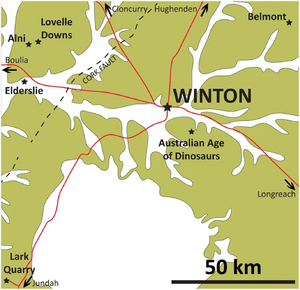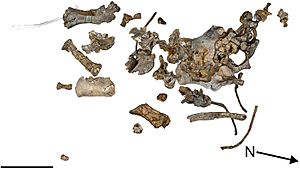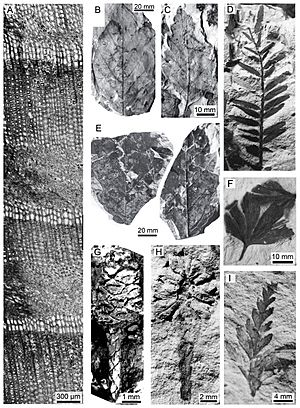Savannasaurus facts for kids
Quick facts for kids Savannasaurus |
|
|---|---|
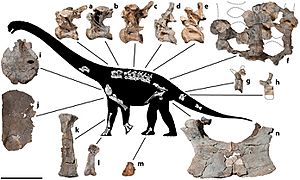 |
|
| Skeletal diagram and selected fossils | |
| Scientific classification | |
| Genus: |
Savannasaurus
|
| Species: |
elliottorum
|
Savannasaurus was a type of long-necked, plant-eating dinosaur called a titanosaur. It lived during the Late Cretaceous period in Queensland, Australia. Its full name is Savannasaurus elliottorum. Scientists Stephen Poropat and his team named it in 2016. The only known skeleton, nicknamed "Wade", is the most complete sauropod fossil ever found in Australia. It is kept at the Australian Age of Dinosaurs museum. Other dinosaurs living at the same time included its relative Diamantinasaurus and the meat-eating Australovenator. Some teeth found nearby suggest Australovenator might have eaten Savannasaurus.
Savannasaurus was about 15 metres (49 ft) (49 feet) long, making it a medium-sized titanosaur. It had very wide hips, over 1.1 metres (3 ft 7 in) (3.6 feet) wide. This wide body helped spread its weight evenly. It also had strong upper arm bones (humerus) and possibly tall ankle bones (astragalus). These features, along with a flexible spine, likely helped Savannasaurus walk on the muddy ground of the floodplains where it lived. Other titanosaurs also developed similar traits, perhaps because they faced similar challenges in their environments.
Scientists believe Savannasaurus was an early kind of titanosaur, not one of the more specialized types. For example, its backbones (vertebrae) did not have special interlocking joints found in many other titanosaurs. Studies suggest that the ancestors of Savannasaurus and Diamantinasaurus came from Asia or other southern continents like South America. They probably traveled to Australia through Antarctica about 105–100 million years ago.
Contents
Discovering and Naming Savannasaurus
In March 2005, David Elliot, who started the Australian Age of Dinosaurs (AODF), found the first Savannasaurus fossil. He was with his wife Judy and their children. The fossil, called AODF 660, was found on the Belmont sheep station, about 60 kilometres (37 mi) (37 miles) northeast of Winton, Queensland. This site was nicknamed the "Ho-Hum site."
Scientists from the Queensland Museum and many volunteers dug up the fossil in July and September of 2005. The bones were inside a hard rock called a siltstone concretion. Workers used jackhammers and chisels to carefully split the rock. They marked each piece to help put them back together later. Preparing the fossil took about ten years. They used special tools like air scribes and micro-jacks to clean the bones. Then, they used strong glues like superglue and araldite to reassemble the pieces. The markings helped them figure out how the bones were positioned when they were found.
AODF 660 includes about 40 bones. These include bones from its neck, back, hips, and tail. It also has parts of its shoulder, arm, and hand bones. Some hip and foot bones were also found. This fossil is the most complete sauropod skeleton ever found in Australia. It represents about 20% to 25% of the entire animal.
The bones were spread out over a small area, less than 20 m2 (220 sq ft) (215 square feet). Even though the backbones were not connected, they were found in order. This helped scientists identify them. The ribs on the left side of the body seemed to have been crushed before they became fossils. The fifth backbone and both upper arm bones show signs of being stepped on by other dinosaurs. This might explain why the bones were scattered. However, they were less scattered than other dinosaur fossils from the same time.
The fossil was nicknamed "Wade." In 2016, Stephen Poropat and his team officially described and named it Savannasaurus elliottorum. The name Savannasaurus comes from a word meaning "savanna," referring to the environment where it was found. The name elliottorum honors the Elliott family for their important work in Australian paleontology.
Physical Description of Savannasaurus
Savannasaurus was a medium-sized titanosaur. It was about 15 metres (49 ft) (49 feet) long. It weighed around 20 tonnes (22 short tons) (22 short tons) and stood about 3 metres (9.8 ft) (10 feet) tall at its shoulders.
Backbone and Tail Bones
Like most other large sauropods, the bones in Savannasaurus' backbone (vertebrae) had small holes. These holes were made by air sacs, making the bones lighter. These vertebrae also lacked special interlocking joints. The neck and back vertebrae of Savannasaurus were convex (curved out) at the front and concave (curved in) at the back. This is common in many large sauropods.
One of its tail bones had an unusual wavy front surface. It was concave on the top half and convex on the bottom half. Scientists think this might be a unique feature of Savannasaurus. Other tail bones were concave on both ends, which is rare for titanosaurs.
The only known neck bone of Savannasaurus came from the back of its neck. Unlike most titanosaurs, this bone had a subtle ridge along its bottom. This is a feature seen in older types of sauropods. The side of the neck bone had a deep groove that ran almost its entire length.
The backbones of Savannasaurus were wider than they were tall. They had weakly developed ridges on their bottom sides, similar to Diamantinasaurus. Like many other sauropods, the sides of its backbones had teardrop-shaped holes for air sacs. The bony plates connecting the front joints of the backbones were V-shaped in the front, but flat in the rear. Interestingly, these plates were not perfectly symmetrical. The left side of the vertebrae had extra bony support. Also, unlike some other titanosaurs, the spines on top of the backbones grew taller towards the rear of the back.
The first two tail bones of Savannasaurus had another unique feature. They had shallow hollows on their sides around small holes. This was previously thought to be a feature only of brachiosaurids, another group of large sauropods. Other tail bones further back were also found. Their lengths did not change much, but their shapes varied.
Shoulders and Front Limbs
Savannasaurus had two unique features in its breastbones (sternal plates). First, they were D-shaped with straight outer edges when viewed from below. Other titanosaurs usually had kidney-shaped breastbones. Second, they lacked the long ridges found on the bottom of most other large sauropods' breastbones. These breastbones would have been about 71% as long as its upper arm bones.
The shoulder blade (coracoid) was oval-shaped. The joint where the upper arm bone connected was much larger than in Diamantinasaurus. The upper arm bone (humerus) of Savannasaurus was very strong, similar to Diamantinasaurus and other titanosaurs. The lower arm bone (radius) was twisted, a feature seen in only a few other sauropods.
The hand bones (metacarpals) of Savannasaurus were arranged like a horseshoe. The third metacarpal was the longest, followed by the second, first, fourth, and fifth. The third metacarpal was about 49% the length of the radius, which is short for a titanosaur. A unique feature was that the bottom of the fourth metacarpal was shaped like an hourglass. In life, the hand bones would have been close together at the top and spread out at the bottom. It's unusual for titanosaurs to have finger bones (phalanges), but Savannasaurus and Diamantinasaurus did. Most of its digits likely had finger bones.
Hips and Hind Limbs
The most striking feature of Savannasaurus was its incredibly wide hips. Its hip bones (sacrum) were 1.07 metres (3 ft 6 in) (3.5 feet) wide. Its fused hip bones (ischium-pubis complex) were at least 1.14 metres (3 ft 9 in) (3.7 feet) wide. Its breastbones were also very wide, about 85 centimetres (2 ft 9 in) (2.8 feet), to match its wide body. While titanosaurs generally had wide bodies, Savannasaurus was exceptionally wide-hipped, only surpassed by a few others.
Other hip proportions were also unusual. The ischium, one of the hip bones, was relatively short, being only 63% as long as the pubis (another hip bone). In most other titanosaurs, it was at least 70% as long. A unique feature of Savannasaurus was that the front-to-back length of the ischium was only 42% of its width.
Another unique feature of Savannasaurus is a subtle ridge on the front upper part of its pubis. This ridge is parallel to another ridge below an opening called the obturator foramen. Like Diamantinasaurus, it had an expanded "boot" at the tip of the pubis.
In its ankle, the astragalus bone was taller than it was wide or long. This is unusual for titanosaurs. Two ratios in this bone are unique: its side-to-side width was 87% of its height, and 98% of its front-to-back length.
How Savannasaurus is Classified
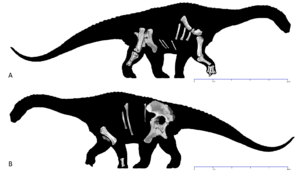
In 2016, scientists Stephen Poropat and his team studied the family tree of Savannasaurus and Diamantinasaurus. They found that Savannasaurus and Diamantinasaurus belonged to a group (clade) close to the base of the Titanosauria family. This means they were early members of the titanosaur group, not part of the more specialized group called Lithostrotia. Many other studies have found similar results.
In 2020, Poropat and his team listed several features that support Savannasaurus being outside the Lithostrotia group. These include the flat bony plates in its backbones, the lack of squeezing in its hip vertebrae, its tail bones being concave on both ends, and its D-shaped breastbones. Also, the fact that it had finger bones (phalanges) and lacked a ridge on the side of its pubis points to it being an early titanosaur.
However, some other studies have found different results. Some analyses suggest that Savannasaurus and Diamantinasaurus might be closely related to Baotianmansaurus and Dongyangosaurus. Savannasaurus shares some features with these dinosaurs, like tail bones that are concave on both ends. But unlike Savannasaurus, Baotianmansaurus had interlocking joints in its vertebrae.
Where Savannasaurus Lived (Palaeobiogeography)
During the Cretaceous period, the southern supercontinent of Gondwana began to break apart. This led to more diverse dinosaur groups. It was thought that dinosaurs from Gondwana (like Australia) would be closely related. However, some Australian dinosaurs from the mid-Cretaceous seemed more related to northern (Laurasian) dinosaurs. This was surprising because Laurasia and Gondwana were already separated by a large ocean.
In 2016, Poropat and his team studied this idea. They found that the ancestors of Australian sauropods like Savannasaurus, Diamantinasaurus, and Wintonotitan likely came from Asia. When they considered the geography of the Cretaceous period, they also found that ancestors might have come from South America, Africa, and India/Madagascar.
By combining their studies with estimates of fossil ages, scientists believe that large sauropods like Savannasaurus had spread widely across the world by 131 to 125 million years ago. However, these groups later became limited to certain areas. They estimated that the ancestors of Savannasaurus and Diamantinasaurus reached Australia by the late Albian epoch, about 105 to 100 million years ago.
Scientists think the most likely way they reached Australia was by starting in South America and crossing through Antarctica. During the Aptian to early Albian epochs, this part of Australia was very far south, at about 70°S latitude. The climate was cool and temperate. No sauropods have been found from these cold regions, suggesting they preferred warm climates. So, they probably couldn't cross Antarctica until the late Albian, when global warming made the climate milder. This climate preference might also explain why Australian dinosaurs sometimes seemed more related to northern dinosaurs.
How Savannasaurus Lived (Paleobiology)
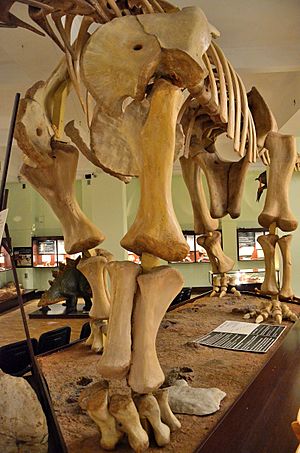
Like all titanosaurs, Savannasaurus likely had a "wide-gauge" stance. This means it stood and walked with its feet far apart from its body's center line. In 2020, Poropat and his team pointed to its wide breastbones and hip bones as proof of this wide stance. The strong upper arm bones of Savannasaurus were also likely an adaptation for this wide stance. They also thought the unusual shape of its ankle bone helped support its weight.
Scientists noted that Savannasaurus and Diamantinasaurus lived on a floodplain with clay-rich soil and heavy rainfall. This means the ground would often be muddy and dangerous for large dinosaurs. They believe that the environment might have favored dinosaurs that could move well in mud. Savannasaurus might have spent more time near water than other sauropods.
A flexible spine, a barrel-shaped body (like a hippopotami), a wide stance, and strong front limbs would all help distribute its body weight. These features would have been useful for living in a muddy environment. Scientists think that other titanosaurs might have developed similar body plans due to similar environmental pressures. This means the "typical" titanosaur body shape might have appeared many times independently.
Ancient Environment of Savannasaurus (Palaeoenvironment)
The Belmont sheep station is part of the Winton Formation rock layers. These rocks date to around 93.9 million years ago, near the boundary between the Cenomanian and Turonian epochs. This is the youngest rock unit from the Mesozoic era in the Eromanga Basin.
The Winton Formation has several types of rocks. These rocks suggest that Savannasaurus lived on a freshwater floodplain. This area had wide, slow-moving rivers and was sometimes flooded.
During the Cenomanian and Turonian epochs, the Winton area was located far south, at about 50°S latitude. Leaf fossils show that the climate was warm, with an average temperature of 16 °C (61 °F) (61°F), and wet, with over 1,300 millimetres (51 in) (51 inches) of rain each year. The weather was seasonal, but there wasn't a big difference between wet and dry seasons like today. The growing season for plants was long, about eight to nine months.
Conifers and flowering plants were the most common plants. Other plants included ferns, liverworts, horsetails, and ginkgoes.

Savannasaurus shared its home with many other animals in the Winton Formation. Other dinosaurs included the sauropods Diamantinasaurus matildae and Wintonotitan wattsi. The meat-eating theropod Australovenator wintonensis also lived there. A tooth from Australovenator was found near the Savannasaurus fossil. This suggests that Australovenator might have eaten the Savannasaurus carcass.
Other animals included the pterosaur Ferrodraco lentoniT (a flying reptile) and the crocodilian Isisfordia duncani. There were also turtles, lizards, lungfish, and ray-finned fish. Invertebrates like bivalves, snails, dragonflies, and scorpionflies also lived there.
See also
 In Spanish: Savannasaurus elliotorum para niños
In Spanish: Savannasaurus elliotorum para niños


